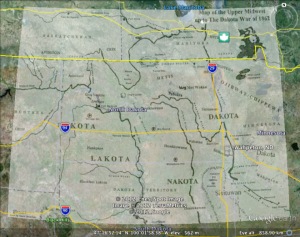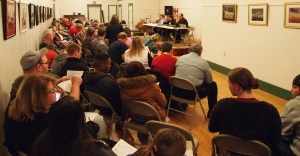04/06/2013
US-Dakota Wars, Then and Now: Ellendale, North Dakota, April 5, 2013
 Last night in Ellendale, North Dakota (not far from a September 1863 massacre site of memory and mourning that is Whitestone Hill), a panel discussion between Natives and non-Natives took place at the Ellendale Opera House. The discussion opened with introductory remarks by North Dakota State University’s Tom Isern, and then by philosopher of ethics, Professor Dennis Cooley (Dennis is co-founder of the Northern Plains Ethics Institute, linked to here). From there Richard Rothaus provided an overview of the US-Dakota Wars that started in the Minnesota River Valley, 1862, but did not end in Mankato with the largest execution in United States history. In the following years, the US engaged in a protracted punitive campaign against all Sioux, regardless of whether they participated in the US-Dakota Wars throughout the Minnesota River Valley in 1862 — the many were punished for the actions of a few.
Last night in Ellendale, North Dakota (not far from a September 1863 massacre site of memory and mourning that is Whitestone Hill), a panel discussion between Natives and non-Natives took place at the Ellendale Opera House. The discussion opened with introductory remarks by North Dakota State University’s Tom Isern, and then by philosopher of ethics, Professor Dennis Cooley (Dennis is co-founder of the Northern Plains Ethics Institute, linked to here). From there Richard Rothaus provided an overview of the US-Dakota Wars that started in the Minnesota River Valley, 1862, but did not end in Mankato with the largest execution in United States history. In the following years, the US engaged in a protracted punitive campaign against all Sioux, regardless of whether they participated in the US-Dakota Wars throughout the Minnesota River Valley in 1862 — the many were punished for the actions of a few.I think one of the main reasons folks came to this — and they expressed it — was to listen to what Tamara St. John (Sisseton-Wahpeton Oyate, South Dakota) and Ladonna Brave Bull Allard (Standing Rock Tourism Director, North Dakota) had to say. Toward the end of the conversation, several of the Ellendale residents expressed immense thanks for the opportunity to listen, and one individual said they will use this panel discussion to navigate how to go about organizing the 150th year event at Whitestone Hill this September.

The US-Dakota War Panel Discussion from April 5, 2013, at the Opera House in Ellendale, North Dakota.

No comments:
Post a Comment